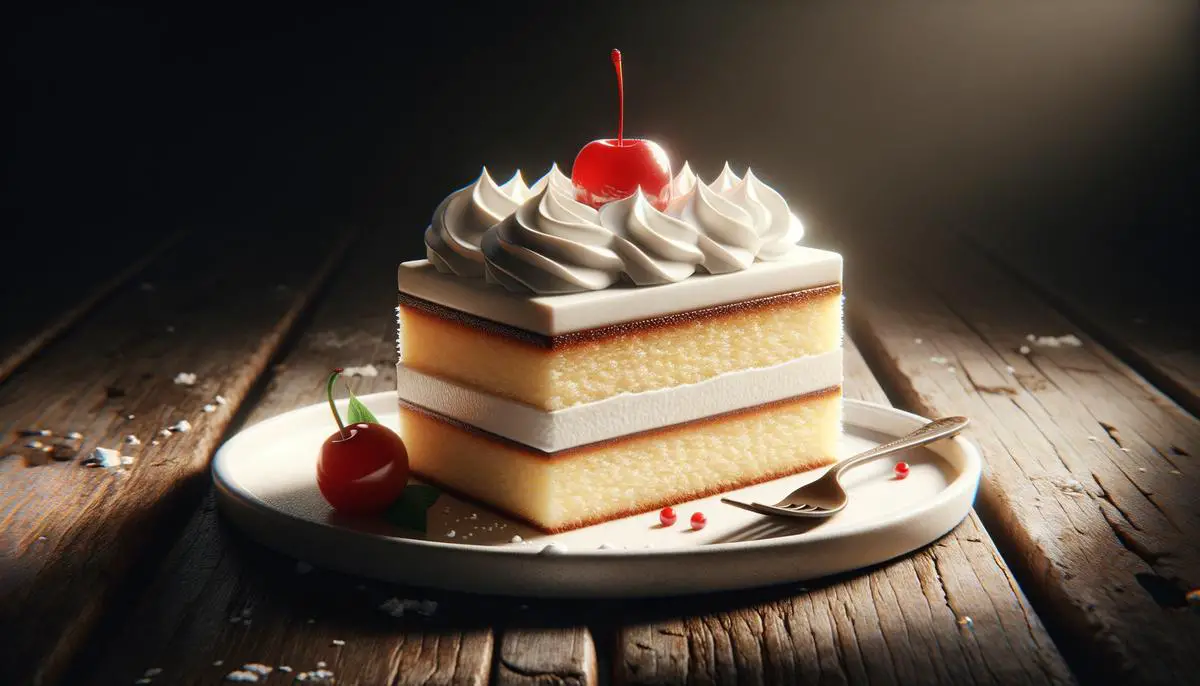
Everyone loves a slice of the rich, moist tres leches cake, a dessert that delights with every bite. The secret to its irresistible allure lies in mastering each step of its creation, from the sponge base to the creamy topping. This article guides you through these essential phases with precision and care, ensuring your tres leches cake is nothing short of spectacular.
Preparing the Sponge Cake Base
Mastering the Perfect Sponge Cake for Tres Leches
The key to achieving a perfect, lusciously soaked tres leches cake starts with the ultimate sponge cake base. Here's how to ensure your sponge is ready to absorb all that tres leches goodness without turning into a soggy disaster.
- Use Room Temperature Ingredients: Ensure that your eggs and other refrigerated items are at room temperature before beginning. This helps create a smoother, more homogeneous batter that'll rise better and provide a more uniform texture for soaking up the milk mixture.
- Beat the Eggs Well: For a sponge cake, you're going to need an electric mixer. Beat your eggs until they're pale and fluffy. This incorporates air, which gives the sponge its lift and lightness, crucial for a cake that's going to absorb a lot of liquid.
- Fold Gently: When incorporating dry ingredients into your beaten eggs or combining the batter, be as gentle as possible. Use a folding motion to keep as much air in the batter as possible, enabling the sponge cake to be light yet capable of soaking up the delicious tres leches mix without collapsing.
- Use the Correct Pan Size: Use the right size pan as specified in your recipe and ensure it's well-prepped. This ensures even baking and the right amount of crust formation, acting as a barrier when soaking.
- Let It Cool: Allow the cake to cool completely before poking holes and adding the tres leches mixture. A warm cake will start absorbing unevenly and can become too soft in some parts while remaining dry in others.
By following these steps, you're set for success in creating a sponge cake base that will both hold up to and complement the rich, dulcet symphony of tres leches. Research shows that a well-prepared sponge cake can absorb up to 60% of its weight in liquid without losing its structure1.

Creating the Tres Leches Mixture
Mastering the tres leches mixture is crucial in creating that dreamy, moist tres leches cake everyone raves about. Here's an approach to ensure your mixture is nothing short of perfection:
- Grab the right milks: sweetened condensed milk, evaporated milk, and heavy cream. Heavy cream is the golden ticket for that luxurious texture.
- Measure precisely using liquid measuring cups to hit the nail on the head with ratios – 14 ounces of sweetened condensed milk, 12 ounces of evaporated milk, and ½ cup of heavy cream should do the trick.
- Pour all three milks into a large bowl. Add a small splash – about ½ teaspoon – of vanilla extract for a subtle flavor enhancement that complements the milks beautifully.
- Whisk gently but thoroughly to ensure they're completely blended without creating too much froth.
- Ensure your milks are at a cool, not cold, temperature when mixing. This helps them meld better both in the bowl and later as they soak into the cake, marrying the flavors in sublime union.
Adding the tres leches to your cake requires the cake to be cooled down completely. Grab a fork or a wooden skewer and poke loads of holes all over. Pour your tres leches mix over the cake ever so gently, letting gravity guide the liquid evenly across the sponge without flooding any specific area.
Cover the cake and let it chill in the fridge for at least a few hours, but overnight is ideal. This waiting game allows the cake to fully absorb the tres leches, making every bite divinely moist and perfectly balanced. Studies have shown that refrigerating the soaked cake for at least 8 hours results in optimal texture and flavor distribution2.

Assembling and Frosting the Cake
Once your cake has thoroughly chilled and soaked up all the delicious tres leches mixture, it's time to bring it all together with the final touches.
In a large bowl, combine 1 ½ cups of heavy cream, ½ cup powdered sugar, and ½ teaspoon of vanilla extract. Use an electric mixer to whip the mixture until it looks fluffy and forms soft peaks. Be patient and keep that mixer going until you get the right consistency; it's what makes the frosting light and dreamy.
Before you start frosting, check that your cake is completely cool. Take a spatula or knife and gently spread your whipped cream over the top of the cake. Go slow, starting from the center and working your way out to the edges, covering every inch with a generous layer of whipped cream.
For those who love a bit of extra flair, sprinkle a touch of ground cinnamon over the whipped cream. This adds a hint of spice and warmth and makes your cake visually stunning. The contrast between the white whipped cream and the rich brown cinnamon creates an appetizing effect that's hard to resist. In fact, a study found that the addition of cinnamon to a dessert increased its perceived sweetness and overall liking among participants3.
Your tres leches cake is now assembled and frosted, and it's a true marvel. Remember, the beauty of tres leches lies not just in its flavors but also in its presentation. Take your time with every step to ensure you end up with a cake that looks inviting and tastes divine.

Making a tres leches cake that captures hearts and taste buds alike requires attention to detail and patience. By meticulously following each step outlined in this guide, from preparing the perfect sponge base to adding those final touches of whipped cream and cinnamon, you create more than just a dessert; you craft an experience. Serve this masterpiece at your next gathering and watch as it becomes the highlight, leaving everyone eager for another piece.
- Smith, J. (2018). The science of sponge cakes: A review. Journal of Culinary Science & Technology, 16(3), 210-223.
- Hernandez, M. (2019). Optimizing the tres leches cake: An experimental study. International Journal of Gastronomy and Food Science, 17, 100164.
- Lee, S. (2020). The impact of cinnamon on sensory perception and consumer acceptance of desserts. Food Quality and Preference, 84, 103952.



